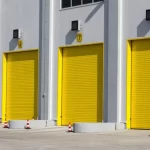Types of Industrial Roller Shutter Doors and Their Benefits

Industrial roller shutter doors are essential components in various industrial and commercial settings, providing security, convenience, and efficiency. In this blog post, we will explore different types of industrial roller shutter doors and delve into their unique benefits. From rolling shutters and sectional overhead doors to fire and smoke curtains, high-speed rolling shutters, hangar doors, loading solutions, bullet resistant doors, blast resistant doors, and fire-rated steel doors, we will uncover the advantages each type offers for different industrial applications.
Rolling Shutters:
Rolling shutters are versatile and widely used in industrial settings. They provide excellent security against unauthorized access, protect against harsh weather conditions, and offer insulation properties for temperature control. With their durable construction and customizable options, rolling shutters ensure enhanced safety and operational efficiency.
Sectional Overhead Doors:
Sectional overhead doors are commonly found in warehouses, loading docks, and industrial facilities. They offer space-saving benefits, allowing easy access for large vehicles and accommodating different types of openings. Sectional overhead doors are known for their robust construction, insulation properties, and smooth operation, improving productivity and security in industrial environments.
Fire And Smoke Curtains:
Fire and smoke curtains play a crucial role in preventing the spread of fire and smoke in industrial settings. These specialized curtains are designed to automatically deploy in case of a fire, effectively compartmentalizing areas and protecting valuable assets. Fire and smoke curtains enhance safety and minimize property damage, ensuring compliance with fire safety regulations.
High-Speed Rolling Shutters:
High-speed rolling shutters are engineered for rapid opening and closing, optimizing workflow and minimizing energy loss. With their advanced technology and fast operation, high-speed rolling shutters enable efficient traffic flow, temperature control, and security. They are particularly beneficial in busy industrial environments with frequent access needs.
Hangar Doors:
Hangar doors are specifically designed for aviation facilities, providing large-scale access for aircraft and efficient maintenance operations. These doors are engineered to withstand extreme weather conditions and offer enhanced security. Hangar doors ensure the smooth flow of air traffic, enable quick aircraft turnaround, and enhance safety for both aircraft and personnel.
Loading Solutions:
Loading solutions encompass a range of equipment such as dock levelers, vehicle restraints, and loading docks designed to streamline the loading and unloading process. These solutions ensure safety, efficiency, and reliable connectivity between loading bays and vehicles, minimizing downtime and optimizing workflow in industrial logistics.
Bullet Resistant And Blast Resistant Doors:
Bullet resistant and blast resistant doors provide unparalleled protection against potential threats in high-security industrial environments. Engineered with specialized materials and construction techniques, these doors offer resistance to ballistic impacts and explosions, ensuring the safety of personnel and assets.
Fire-Rated Steel Doors:
Fire-rated steel doors are essential in industrial facilities, offering passive fire protection and compartmentalization. These doors are designed to withstand the spread of fire for a specified period, providing valuable time for evacuation and reducing property damage. Fire-rated steel doors help maintain safety and compliance with fire safety regulations.
Fire-rated steel doors are essential in industrial facilities, offering passive fire protection and compartmentalization. These doors are designed to withstand the spread of fire for a specified period, providing valuable time for evacuation and reducing property damage. Fire-rated steel doors help maintain safety and compliance with fire safety regulations.





